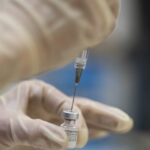By Marina Zhang
In this series, we evaluate some of the lesser-known yet common COVID-19 vaccine adverse events that are appearing in the research literature as well as in doctors’ clinics and, more importantly, how to deal with them and reduce the risks.
Before 2021, Ruth Davy ran more than three miles daily and could cycle up to 46 miles on her bike despite being in her 60s.
But her life changed 15 minutes after she got her first of two COVID-19 vaccine doses.
“I felt like I was sedated,” Davy told The Epoch Times about her experience after the first dose. “My whole body was shutting down.”
Davy is no stranger to neurological vaccine side effects. In 2008, she developed Guillain-Barré syndrome due to taking Vivaxim and Dukoral for travel. Her legs gave out, and she was bedridden, although her symptoms disappeared after she went on supplement protocols.
In 2021, COVID-19 vaccinations were mandated in her workplace, so she got the COVID-19 vaccine to keep her job.
After each dose, new neurological symptoms manifested. Following Davy’s second dose, she lost control of the muscles in her right calf, which stayed contracted.
“I was paralyzed for a week,” she said. “[The muscles in] my right calf solidified to the point that I couldn’t stretch my legs.”
After more than a week of going on various health protocols, Davy’s muscle contractions were alleviated.
Her rheumatologist told her that she had developed a new autoimmune condition following vaccination, although a definite diagnosis hasn’t yet been given.
Movement Disorders With Completely Novel Symptoms
While health authorities assert that post-vaccine adverse events are rare, Davy said her local medical specialists told her that they have “hundreds of patients” with similar post-vaccine symptoms like hers, relating to movement disorders.
“I am not rare; I am quite common,” she said.
Movement disorders manifest because of brain and neural abnormalities caused by infection, inflammation, neurodegeneration, adverse drug effects, and chronic disease.
Patients may develop a slowing of motion, such as Parkinson’s disease and paralysis, or an increase in motion, such as involuntary jerks and tics. Other symptoms include dancing movements (chorea), gait disturbances, stiffness in limbs and trunk, garbled speech, difficulty swallowing, and many more.
Neurologist Dr. Suzanne Gazda, who has treated several hundred post-vaccine patients, told The Epoch Times that most post-vaccine movement disorders have been entirely novel presentations, meaning that they “don’t fall into a conventional diagnosis.”
Therefore, it has been a great challenge for doctors to diagnose and treat patients.
Gazda said patients might present with symptoms that are multiple sclerosis-like, stroke-like, and Alzheimer’s disease-like but aren’t entirely consistent. Laboratory tests and scans also often return with normal findings, which may make a less-informed doctor conclude that the patient is perfectly healthy despite their debilitating symptoms.
Unusual Cases
Gazda gave an example of patients who develop seizure-like convulsions that last for hours, even though seizures typically last from seconds to minutes.
Dr. Robert Lowry, a board-certified surgeon specializing in brain injury, said several patients developed unusual transverse myelitis following COVID-19 vaccination.
Transverse myelitis occurs when a spinal cord section becomes inflamed, causing muscles and organs to become weak and dysfunctional. Typically, one or two consecutive vertebral segments are affected, but Lowry’s patients often have three or more vertebral segments involved in succession.
Critical care specialist Dr. Pierre Kory, who now operates a long-COVID and vaccine-injury private clinic with nurse practitioner Scott Marsland, told The Epoch Times that he has seen patients whose muscle weakness was on track to be diagnosed as multiple sclerosis. Their scans also showed lesions and damage in the nerves, but the unusual thing is that the lesions didn’t always match with symptom location. Patients’ muscle weakness can also be episodic, with the affected areas changing from day to day.
Many Cases Are Diagnosed as Psychosomatic, Posing a Risk
These new and complex movement disorders in vaccinated individuals can be very confusing for doctors. Many of these patients have been misdiagnosed as having functional disorders.
“Functional neurologic disorder (FND), also known as conversion disorder and functional neurologic symptom disorder, refers to a group of common neurological movement disorders caused by an abnormality in how the brain functions. FND is not caused by another disorder and there is no significant structural damage in the brain. The exact cause of FND is unknown. FND was thought to be a ‘conversion disorder’ by Sigmund Freud because he believed a psychological disorder converted into a neurological one,” notes an explanation by the National Institute of Neurological Disorders and Stroke.
This diagnosis is usually given when patients’ symptoms don’t match any known neurological disease and scans and tests show no damage to the brain or neurons.
Since this diagnosis is only given when no injury is detected, patients’ symptoms are assumed to be caused by poor psychological health or stress. Therefore, treatment involves counseling, trauma therapy, mindfulness, and physical and occupational therapy.
Gazda said she has only seen a few cases of functional disorder over more than 30 years of clinical practice. Since the COVID-19 pandemic, about 90 percent of her vaccinated patients with neurological side effects were diagnosed with a functional neurological disorder prior to referral.
Several case studies documented functional neurological disorders involving movement issues following vaccination. For example, a Canadian study published in December 2022 found that roughly half of 21 patients who developed symptoms post-infection or post-vaccination were diagnosed with a functional disorder.
Functional neurological disorders also increased prior to vaccination, with one study observing a 90 and nearly 60 percent increase in pediatric and adult functional disorder patients in 2020, respectively.
Gazda and Kory argued that functional neurological disorders in vaccinated individuals likely aren’t functional but caused by the spike protein—the central pathogenic part of the COVID-19 virus that is also generated by the vaccine. This reasoning is based on the fact that patients with functional disorder diagnoses have improved once they were given treatment focused on removing the spike protein.
The incorrect functional disorder diagnosis can delay treatment, impeding recovery as symptoms worsen. For example, Kory recounted the case of a boy who developed strange movement disorder symptoms post-vaccine and was treated as a functional disorder patient for two years. The boy’s symptoms worsened as he was treated in various functional disorder centers, but he finally experienced improvements once he was recognized and treated as a vaccine-injured patient.
It’s dangerous to diagnose patients with functional neurological disorders, according to Gazda. As time passes, patients may start to believe that all of their symptoms are only mental, and they may stop seeking treatment for their physical symptoms.
The Causes Behind Movement Disorder Among the Vaccinated
Doctors believe that the No. 1 culprit behind post-vaccine reactions is the spike protein, a surface protein the virus uses to invade human cells. In vaccinated individuals, the body’s cells make spike protein to trigger the immune system’s reaction so that the person can gain protection from COVID-19.
The spike protein was chosen as the target for COVID-19 vaccine development because once the body forms an immunity against the spike protein, its antibodies can directly neutralize and block COVID-19 infections.
Both the COVID-19 mRNA and adenovirus vaccines cause the body to produce what’s likely to be high quantities of viral spike proteins for an unknown period (pdf). The Novavax vaccine, on the other hand, doesn’t cause the body to produce spike proteins but injects the body with already produced spike proteins.
However, researchers and doctors now realize that the spike protein is potentially toxic and inflammatory and may not have been a good candidate for vaccination.
Neuroinflammation from spike protein exposure may contribute to movement disorders in vaccinated patients, according to Kory.
Studies have shown that spike proteins can cross the blood-brain barrier and cause immune cells, also known as microglia cells, to become inflammatory and degenerative. Microglial cells clean up debris and infection in the brain but once switched on, it’s tough to switch them off; therefore, the person’s brain may be in a chronic state of inflammation.
Doctors can use MRI and specialized imaging softwares to look for inflammation and shrinkage of the brain and nerves. Still, they may not recognize early inflammation and disease as the differences are minor and indiscernible. Gazda said that once pathology becomes visible on the routine MRI, the patient may have significant clinical progression.
Neuroinflammation has been implicated in movement disorders, including Parkinson’s disease, Tourette syndrome, involuntary movement, and many more. The fact that patients with movement disorders improve after taking anti-inflammatory therapeutics is a sign that neuroinflammation is an underlying factor, Kory said.
Other potential effects of spike protein include its ability to induce autoimmunity. A study by immunologist Dr. Aristo Vojdani found that antibodies made against spike proteins can act against 28 different human tissues, including various tissues in the nervous system.
The spike protein can also induce clotting. Studies have found that the spike proteins from the COVID-19 infection can induce microclot formation in the blood.
Lowry believes that microclotting is a significant reason for vaccine injuries, having observed several cases of atypical stroke in which blood clots were detected in blood vessels leaving the brain, suggesting that the blood may clump together in the brain. A stroke is typically caused by a hemorrhage or clot from outside the brain that deprives the brain of blood.
Recognition of Vaccine Injuries Important in Treatment
Gazda and Kory highlighted that doctors should know about spike protein harms to recognize potential vaccine reactions and prescribe treatment that targets the root cause.
When a patient’s neurological disorder has a strong temporal association with the vaccine, Kory wonders if treating the patient for their vaccine injury would be more helpful than prescribing conventional treatment for the specific neurological disease. However, the lack of recognition of vaccine reactions means no studies have been done comparing treatment effectiveness.
Neurologist Dr. Diane Counce, who has seen an uptick in vaccinated patients presenting with Parkinson’s, told The Epoch Times that she prescribes both conventional and vaccine-targeted therapy to vaccinated individuals, hoping that it will improve patients’ prognosis.
In treating neuroinflammation, apart from common anti-inflammatory drugs such as ivermectin and low-dose naltrexone, Kory found that movement disorder patients have also been responsive to methylene blue, corticosteroids, and glutamate inhibitors.
Methylene blue shouldn’t be taken with serotonergic agents such as selective serotonin reuptake inhibitors. Corticosteroids generally aren’t recommended for long-term use. Some people may be allergic to the ingredients in glutamate inhibitors, and certain health conditions, such as blood pressure and coronary heart disease, may contraindicate with these drugs.
Antibody infusions such as IVIG may treat movement disorders linked with autoimmunity. But since the treatment isn’t approved by the U.S. Food and Drug Administration (FDA) for movement disorders, autoimmunity would need to be proven for insurance reimbursement, according to Gazda.
Counce recommends anticoagulants, such as aspirin and nattokinase, to prevent blood clot formation. Serrapeptase and nattokinase can also help break down spike proteins, preventing further harm.
Looking for Alternatives
Kory said long COVID and COVID-19 vaccine injuries have been very different from all previous diseases that he has treated. Previously, there were solid trends and patterns he could recognize with symptoms and the way patients responded to treatment. However, that hasn’t been the same with long-COVID and vaccine-injury patients; two patients with the same symptoms may react differently to a treatment.
Another difficulty in treating these patients is that there’s no way to verify if spike proteins have been eliminated. Doctors worry that these proteins may persist and retrigger reactions, according to Gazda.
Despite the problems, she said treating these patients has been very rewarding since doctors are now trying to treat the root cause of the disease rather than solely focusing on the symptoms.
The appearance of COVID-19 vaccine injuries may have also inadvertently pushed doctors to introduce alternative medical practices into their clinics. For example, Counce, an allopathic neurologist, said she has started looking into red light therapy and other therapies that initially would have been considered on the fringe of modern medicine.
Rather than prescribing pharmaceuticals to control symptoms, Gazda said doctors are now trying to heal patients using dietary and lifestyle changes that allow patients to become healthier rather than having their symptoms masked.
Next: Musician and singer Emaline Delapaix has consulted at least 16 medical specialists, all of whom believe that her conditions are linked to the vaccine. She has been diagnosed with mast cell syndrome, a potentially deadly condition in which “everything that comes in could be an enemy,” she said.
Previously: Three days postvaccine, former Pussycat Dolls member Jessica Sutta woke up to “the most excruciating muscle spasms” that were unlike anything she had ever experienced, she said.
Read Part 1 – Major Countries Officially Report 100 Deaths Caused by COVID-19 Vaccines
Read Part 2 – Vision Impairments in Patients After COVID-19 Vaccination, Doctors Caution Possible Risks
Read Part 3 – Tinnitus: A Common Incurable COVID-19 Vaccine Adverse Event, Doctors Share Ways to Help
Read Part 4 – Atypical Small–Fiber Neuropathy Occurrence After COVID-19 Vaccination, Possibly Underdiagnosed






